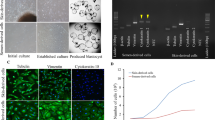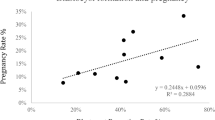Abstract
Six types of bovine somatic cell lines, including a granulosa cell line of Chinese red-breed yellow cattle (YGR), a granulosa cell line of Holstein cow (HGR), two skin fibroblast cell lines of two adult Holstein cows respectively (AFB1 and AFB2), a skin fibroblast cell line (FFB) and an oviduct epithelial cell line (FOV) of a Holstein fetus, were established. Somatic cell nuclear transfer (SCNT) was carried out using these cells as nuclei donor, and a total of 12 healthy calves were cloned. The effects of different types of donor cells on developmental potential of bovine SCNT embryos were investigated, (i) There was no significant difference in development rates to the blastocyst stage for SCNT embryos from YGR and HGR (33.2% and 35.1%, respectively). Pregnancy rates of them were 33.3% and 30.2%, respectively; and birth rates were 16.7% and 11.6%, respectively, (ii) Development rates to the blastocyst stage for SCNT embryos from diffetent individuals (AFB1 and AFB2) differed significantly (27.9% and 39.4%, respectively, P < 0.05). Pregnancy rates of them were 36.2% and 36.4%, respectively; and birth rates were 14.9 % and 27.3%, respectively, (iii) There was significant difference in development rates to the blastocyst stage for SCNT embryos from FFB and FOV of the same fetus (37.9% and 41.5%, respectively,P < 0.05). Pregnancy rates of them were 45.7% and 24.1%, respectively; and birth rates were 22.9 % and 10.3%, respectively. Finally, developmental potential of bovine SCNT embryos from all four types of somatic cells from Holstein cows (HGR, AFB, FFB and FOV) were compared. Forin vitro development stage, development rates to the blastocyst stage for SCNT embryos from HGR, AFB, FFB and FOV were 35.1%A, 29.4%B, 37.9%A and 41.5%C, respectively (P ABC < 0.05); forin vivo development stage, pregnancy rates of them were 30.2%, 36.2%, 45.7% and 24.1%, respectively; and birth rates of them were 11.6%, 17.2%, 22.9% and 10.3% respetively.
Similar content being viewed by others
References
Willmut, I., Schnieke, A. E., McWhir, J. et al., Viable offspring derived from fetal and adult mammalian cells, Nature, 1997, 385: 810–813.
Wakayama, T., Perry, A. C., Zuccotti, M. et al., Full-term development of mice from enucleated oocytes injected with cumulus cell nuclei, Nature, 1998, 394: 369–374.
Kato, Y., Tani, T., Tsunoda, Y. et al., Eight calves cloned from somatic cells of single adult, Science, 1998, 282: 2095–2098.
Baquisi, A., Behboodi, E., Melican, D. T. et al., Production of goats by somatic cell nuclear transfer, Nat. Biotechnol., 1999, 17: 456–461.
Wang, Y., Zou, X., Liu, J. et al., Cloned goats (Capra hircus) from foetal fibroblast cell lines, Chinese Science Bulletin, 2000, 45(1): 34–38.
Polejaeva, J., Chen, S. H., Vaught, T. D. et al., Cloned pigs produced by nuclear transfer from adult somatic cells, Nature, 2000, 407: 505–509.
Shin, T., Kraemer, D., Pryor, J. et al., A cat cloned by nuclear transplantation, Nature, 2002, 415: 859.
Chesne, P., Adenot, P. G., Viglietta, C. et al., Cloned rabbits produced by nuclear transfer from adult somatic cells, Nat. Biotechnol., 2002, 20(4): 366–369.
Holden, C., Genetics: First cloned mule races to finish line, Science, 2003, 300: 1354.
Galli, C., Lagutina, I., Crotti, G. et al., Pregnancy: A cloned horse born to its dam twin, Nature, 2003, 424: 635.
Zhou, Q., Renard, J. P., Le Friec, G. et al., Generation of fertile cloned rats by regulating oocyte activation, Science, 2003, 302: 1179.
Guo, J., An, Z., Li, Y. et al., Cloned goats (Capra hircus) from adult ear cells, Science in China, Ser. C., 2002, 45(3): 260–267.
Chen, D., Li, J., Han, Z. et al., Somatic cell bovine cloning: Effect of donor cell and recipients, Chinese Science Bulletin, 2003, 48(6): 549–554.
Gong, G., Dai, Y., Fan, B. et al., Production of transgenic blastocysts by nuclear transfer from different types of somatic cells in cattle, Science in China, Ser. C, 2004, 47(2): 183–189.
Zimmermann, U., Vienken, J., Electric field-induced cell-to-cell fusion, J. Membrane Biol., 67: 165–182.
Wilmut, I., Beaujean, N., de Sousa, P. A. et al., Somatic cell nuclear transfer, Nature, 2002, 419: 583–586.
Hill, J. R., Burghardt, R. C., Jones, K. et al., Evidence for placental abnormality as the major cause of mortality in first-trimester somatic cell cloned bovine fetuses, Biol. Reprod., 2000, 63: 1787–1794.
Rideout, W. M., Eggan, K. and Jaenisch, R., Nuclear cloning and epigenetic reprogramming of the genome, Science, 2001, 293: 1093–1098.
Garry, F. B., Adams, R., McCann, J. P. et al., Postnatal characteristic of claves produced by nuclear transfer cloning, Theriogenology, 1996, 45: 141–152.
Kang, Y. K., Koo, K. B., Park, J. S. et al., Aberrant methylation of donor genome in cloned bovine embryos, Nat. Genet., 2001, 28: 173–177.
Xue, F., Tian, X. C., Du, F. et al., Aberrant patterns of X chromosome inactivation in bovine clones, Nat. Genet., 2002, 31: 216–220.
Wells, D. N., Misica, P. M., Tervit, H. R., Production of cloned calves following nuclear transfer with cultured adult mural granulosa cells, Biol. Reprod, 1999, 60: 996–1005.
Kubota, C., Yamakachi, H., Yang, X. et al., Six cloned calves produced from adult fibroblast cells after long-term culture, Proc. Natl. Acad. Sci. USA, 2000, 97: 990–995.
Cibelli, J. B., Stice, S. L., Golueke, P. J. et al., Cloned transgenic calves produced from nonquiescent fetal fibroblasts, Science, 1998, 289: 1256–1258.
Zakhartchenko, V., Durcova-Hills, G., Stojkovic, M. et al., Effects of serum starvation and re-cloning on the efficiency of nuclear transfer using bovine fetal fibroblasts, J. Reprod. Fertil., 1999, 115 (2): 325–331.
Gong, G., Dai, Y., Fan, B. et al., Production of transgenic claves by somatic cell nuclear transfer, Chinese Science Bulletin, 2004, 49(2): 161–166.
Kato, Y., Yabuuchi, A., Motosugi, N. et al., Developmental potential of mouse follicular epithelial cells and cumulus cells after nuclear transfer, Biol. Reprod., 1999, 61: 1110–1114.
Author information
Authors and Affiliations
Corresponding author
Additional information
These authors contribute equally to this work.
Rights and permissions
About this article
Cite this article
Gong, G., Dai, Y., Zhu, H. et al. Generation of cloned calves from different types of somatic cells. Sci. China Ser. C.-Life Sci. 47, 470–476 (2004). https://doi.org/10.1007/BF03187106
Received:
Issue Date:
DOI: https://doi.org/10.1007/BF03187106




